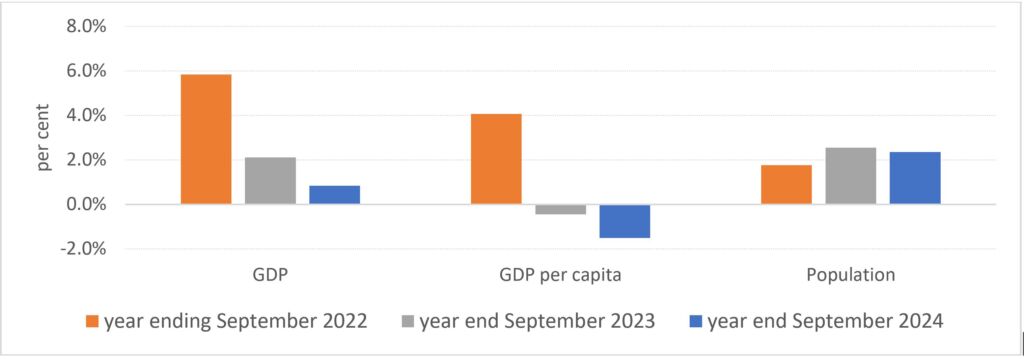February 3, 2025
Introduction
The Go8 comprises Australia’s leading research-intensive universities, producing world class research that enhances the lives of Australians; training a highly skilled workforce essential for business and industry to prosper; and supporting Australia’s most successful services export – international education – that has underpinned economic growth post COVID-19. The Go8 invests $8.5 billion a year in research and development (R&D), which equates to over 20 per cent of the national effort and 70 percent of all university-based research in Australia. Our global top 100 universities collectively graduate around 120,000 students each year, including half of all PhDs.
Go8 universities have a vital role in revitalising Australia’s economic performance and as such are national assets. A strong and vibrant university and research sector is critical to Australia’s future prospects. Whether it be the Government’s longer-term policy of a Future Made in Australia, successfully transitioning the economy to net zero, or safeguarding our national security through AUKUS, success requires the world leading research undertaken at Go8 universities and our high-quality graduates.
The need for economic renewal
Australia is not currently fulfilling its full economic potential. We urgently need to reverse both Australia’s recent tepid economic growth and the longer-term weakness in Australia’s productivity growth, reflected in ongoing structural budget deficits. We need policy reforms that last beyond a budget or electoral cycle.
The Go8 is urging the Australian Government to use the 2025-26 Budget to implement policy reforms which will unshackle Australia’s innovation and productivity capacity, enabling our leading research-intensive universities to realise their potential in contributing to Australia’s future prosperity.
Go8 Recommendations
The Go8 recommends the Australian Government:
- Recognise the overwhelming value of international education to Australia’s economy and that addressing cost of living pressures and housing affordability requires genuine supply side reform, by ceasing the flawed policy of effectively capping international students.
- Make a formal commitment to boosting Australia’s innovation and productivity by adopting a 10-year target for Australia’s investment in R&D to reach 3 per cent of GDP.
- Boost R&D investment by the business and higher education sectors by implementing policy reforms outlined in the July 2024 Go8 report to the Australian Government – Australia’s research and development (R&D) intensity: a decadal roadmap to 3% of GDP.
- Develop a fit for the 21st century national research and industry strategy that includes bipartisan, long-term support for basic (fundamental) research in Australia, including:
- Incorporating national science and research priorities into the strategy.
- Instigating greater diversity of mission, scale and focus among universities delivering research.
- Providing full economic cost support for government research grants to universities.
- Addressing the university sector’s reliance on international student fee revenue to fully fund research.
- Introducing National Strategic research block grants to support core research.
Key messages to Government
- Australia is drifting economically. Recent economic growth figures show we are going backwards in per capita terms and we have a longer-term productivity challenge that is constraining our longer-term prosperity and budget position.
- Australia needs bold policy reform, including a bipartisan national research and industry strategy. Not since Backing Australia’s Ability – the five-year innovation plan launched by the Howard Government in January 2001 – have we seen long term, visionary industry/university policy.
- Both sides of politics are in a race to the bottom on migration, despite the fact that recent immigration-driven population growth has saved the nation from recession.
- Policies to limit international students will not alleviate cost of living pressures or the housing crisis but instead will detract from economic growth.
- To address cost of living pressures and grow the supply side of the economy, including housing, the Australian Government should focus on lifting innovation and productivity.
- To improve Australia’s innovation and productivity we need to revitalise national investment in R&D. The policy reforms in this submission will raise investment by the business and higher education sectors.
Discussion
Australia’s economy and budget continues to face headwinds associated with weaker than anticipated economic activity and uncertain global economic conditions. Australia’s September 2024 national accounts show the lowest annual economic growth since 2020.
Our recent economic growth would have been far worse had it not been supported by population growth (Chart 1), with migration and in particular international student numbers temporarily peaking post COVID-19.
Chart 1: Australia’s recent GDP growth performance (data source: ABS)

Limiting international students is a handbrake on Australia’s economic growth
Spending by international students has assisted the Australian economy at a time when domestic households spending was under pressure. This export income has been invaluable in avoiding a recession. In fact, spending by international students accounted for more than half Australia’s economic growth in 2023.
It is a misjudgment to assign cost of living and housing availability pressures to the temporary influx of international students. Housing supply constraints were a problem well before the return of international students, which are only a small part of overall demand. The net outcome of the policies to limit international students will be to further harm our services exports with no commensurate resolution of cost-of-living pressures.
Instead, the Australian Government should recognise the overwhelming benefits of international education to our economy and society and note the expert advice of the ANU Migration Hub – that the recent spike in international student arrivals was temporary.
Given the negative impacts on economic growth and efforts to diversify and grow services exports, the Australian Government should cease the flawed policy of effectively capping international students. At the very least, if the Government is to persist with this anti economic growth policy, the 2025-26 Budget should look to further target the unscrupulous operators who have exploited international students, as was the initial intent of the Government’s Migration Strategy.
Revitalising productivity
If the Australian Government is serious about addressing cost of living pressures and the supply side of the economy, including housing supply, then the focus must be on lifting productivity. The Productivity Commission has assessed our recent productivity performance as being below average: “Labour productivity is now back to where it was during the stagnant 2015 to 2019 period leading up to the pandemic.”[1] While it is true that globally there has been a dearth of recent strong productivity performance, Australia appears to have a longer-term structural problem.
Investment in R&D is one critical input to innovation and productivity. To our national disadvantage, we lag the OECD average in terms of R&D intensity (R&D investment as per cent of GDP) with recent figures suggesting we are at around 1.7 per cent of GDP. The OECD average is around 2.7 per cent of GDP, a full 1 percentage point higher and the gap has been widening over time.
Industry structure and relative size of businesses in Australia should not be an excuse to address this shortfall in our innovation and productivity potential.
The Australian Government’s Strategic Examination of Research and Development (SERD) and the Productivity Commission inquiries on creating a dynamic and resilient economy provide timely opportunities to consider policy reforms to boost R&D.
The Go8 has undertaken considerable work in this area and will work collaboratively with the Government and the Commission to implement measures to lift Australian investment in R&D.
The Go8 has already examined policy reforms to boost R&D and, with industry and government input, developed a Roadmap report to the Australian Government – Australia’s research and development (R&D) intensity: a decadal roadmap to 3% of GDP – to achieve optimal investment in R&D over a decade.
This ambitious roadmap recognises that an R&D intensity target is not an objective in and of itself, but R&D intensity is a strong indicator of an economy’s long-term innovation and productivity potential.
The target does not lock in Australian Government spending – it is a national target requiring private and public sectors to work together. As a nation, just over half of all R&D expenditure comes from the business sector but its share of total R&D expenditure has gradually declined. The policy reforms in the roadmap recognise we need stronger investment by the business sector to lift our R&D intensity, supported by higher education and government sectors.
National research and industry strategy
We have an outdated and fragmented research architecture that is holding us back – including a funding system that does not fully cover the cost of university research. These are not novel issues – the Go8 has been highlighting these issues for years.
The recent Australian Universities Accord made recommendations to support universities’ capacity to conduct research and research training, but these recommendations have not yet been actioned and now potentially will have to wait another year until completion of the SERD.
Further, Australia has a history of industry policies and programs that lack longevity between governments and/or overlook that their success hinges on world leading research and high-quality graduates (including at PhD level in specialised fields), with which the Go8 is synonymous.
We therefore need to develop a bold and visionary bipartisan national research and industry strategy fit for the 21st century to support basic (fundamental) research in Australia. Key features of this architecture should include:
- Incorporating national science and research priorities into the overall strategy.
- Instigating greater diversity of mission, scale and focus among universities delivering research.
- Providing full economic cost support for government research grants to universities.
- Addressing the university sector’s reliance on international student fee revenue for funding research.
- Introducing National Strategic research block grants to support core research.
Conclusion
Australia needs bold economic leadership to maximise our future prosperity, to ensure that we can realise and achieve economic opportunities and meet the challenges we face as a nation.
The Go8’s evidence based and fiscally responsible recommendations will contribute to putting Australia on a prosperity trajectory, by raising critical R&D investment by the business and higher education sectors that underpins productivity.
Our recommendations also reflect a key facet of the Australian Government’s own fiscal strategy: “Focusing new spending on investments and reforms that build the capability of our people, expand the productive capacity of our economy, and support action on climate change.”
Now is the time for action.
[1] Productivity Commission. (2024), ‘Quarterly productivity bulletin – December 2024’, PC productivity insights, Canberra, p. 2.



